
What is It?
The most recent iteration of this lens was introduced in April 2010. The primary changes that came with the II version were Nano coating, the newer VR motor and features, and the addition of the A/M focus mode. With that out of the way, you can basically consider this a review of both AF-S VR versions (if there’s a difference, I’ll point it out in the review).
It may surprise you to know that the 200-400mm f/4 isn't a completely new concept by Nikon. Way back in 1984 Nikon started making a 200-400mm f/4 ED lens (manual focus). It was actually a bit heavier than the current version, and a bit more awkward to use (it was a very big push/pull design). But those that used it thought very highly of it. As with the current lens, it represented a nice compromise between reach and other factors.
The current version of the lens has basically everything Nikon puts in a lens: ED glass, Nano coating, internal focus, VR II, drop-in filters, rubber weatherproofing seals, hold focus buttons, the ability to return to a predetermined focus point, 9-blade aperture, and fast AF-S motors. You really can't complain about the feature list.
The fixed f/4 aperture means that the lens is a bit slow for 200mm, but perfectly fine for 400mm, where you'll likely use it most. For most subjects you'd shoot at 400mm, you'll get some depth of field isolation, though not like you get with the f/2.8 exotics (especially true on DX bodies). However, note that f/4 means that really only the TC-14E teleconverter falls within the realm of Nikon's autofocus specs (the TC-14E on this lens makes for a respectible 280-560mm f/5.6)—anything above f/5.6 as a maximum aperture is outside the autofocus specs of older cameras, and even the new ones with an f/8 specification tend to focus slower when you push a TC-17E or TC-20E on the 200-400mm.
In practice, though, I did find that the TC-17E and TC-20E are usable on the 200-400mm, but barely. Focus and optical performance is definitely compromised with the TC-17E, and focus performance is compromised with the TC-20E III (you can't trust tracking). I wouldn't recommend using the old TC-20E with the lens, as autofocus is completely unusable and optically the results aren't good. Nor would I recommend using either of the longer TC’s with the first AF-S version of the 200-400mm.
The 6.2 feet (2m) close focus distance is decent for 400mm, a bit long for 200mm. Shooting wildlife in Africa there have been times I've been too close to use the 200-400mm, believe it or not. Likewise, on sidelines of games there will be times when you zoom out but the action just gets too close to you. But that's pretty rare. A word of advice, though: figure out where 6.2 feet (2m) is relative to your position when you're using this lens and the subjects can move towards you. If you're covering sideline action, you probably should be that far off the sidelines, anyway, but I've seen folk get into focusing trouble because they didn't anticipate a close-in subject.
The lens has plenty of focus markings, but no depth of field or infrared focus markings. Foot markings are in yellow, meters in white, but being behind glass I sometimes have trouble seeing the foot markings in certain types of light.
You'll find six switches on the lens:
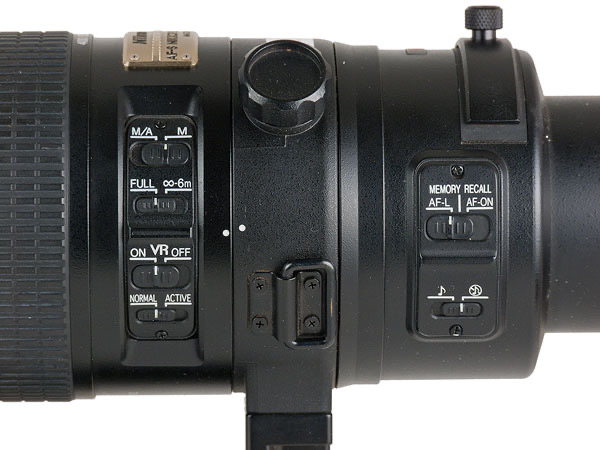
- M/A, M — the universal AF-S switch that allows you to switch between autofocus with manual override, or just manual focus. The new version adds an A/M switch that helps guard against accidental focus change via the focus ring (i.e. delays the switch to manual focus).
- FULL, infinity-6m — a focus limit switch that allows you to tell the lens not to use the 2m to 6m focus range during autofocus operations.
- VR On, Off — the main Vibration Reduction switch, controls whether it is operative or not (Vibration reduction is somewhat self cancelling on tripods).
- Normal, Active — let's you set the VR mode. Normal is what you usually use, but you should switch to Active if you are shooting from a platform that contributes additional irregular motion (auto, boat, plane, etc.).
- AF-L, Memory Recall, AF-On — this three position switch allows you to switch the behavior of the buttons just in front of the focus ring to either lock focus, to force focus to a previously set distance, or to trigger autofocus.
- Beep, No Beep — Provides audio feedback for focus behavior.
In addition, there is a button labeled Memory Set which is used along with the Memory Recall. You set the focus position with Memory Set, you get that last setting back instantaneously by pressing the focus buttons on the lens with Memory Recall set. The beep function is actually mostly there to help provide feedback as to when a distance is stored in memory (one beep for stored, two beeps for recalled).
Unfortunately, this is not a true zoom lens. Thus, if you set focus at one focal length and then zoom, you may need a slightly different focus position (the lens will beep twice short, then three long if this is the case--welcome to the Morse code of lenses).
The lens comes with a light-but-sturdy hood that can be attached backwards onto the lens for carrying. The lens cap is the Nikkor cloth contraption nobody likes.
Filters are via a 52mm drop-in slot at the back of the lens, and Nikon supplies a standard NC filter. Nikon claims that the flat filter is part of the optical formula. This is important, as flat glass will cause a bit of spherical aberration by itself, however you can design for that in the other elements prior to come up with minimal aberrations. Thus, if you shoot without that (or another) flat glass “filter" in place, you’re not going to optimal results.
At the front of the lens, there's the usual curved protective glass element, which is removable (but see note just above about the filter).
The build of the lens is rock solid, and is weather sealed at the mount. Build quality is Nikon's old pro level brought into the 20th century.
Nikon’s page for the lens is here. The lens is made in Japan, and sells for US$7000.
Source of the review samples: personal purchase. Results compared to twelve other sample lenses available to me.
How’s it Handle?
Plenty of people say you can handhold this lens.
Yes, you can, but it's painful to do for any length of time. First, the lens is heavy. But it's also very long (over 18" from front to back with hood on), so you're supporting a lot of that weight well away from you. Basically, you need to get your hands in front of the focus ring to shoot with this lens hand held.
The other option is the rest-in-the-crook-of-your-elbow postion, but I don't like that with this lens as it means you're shooting with a slight twist to your body. Neither position can be held reliably for any length of time, and twisting while holding weight isn't exactly recommended. Thus, invest in a decent monopod (and consider adding the Really Right Stuff or similar monopod head). You'll be glad you did.
On a tripod this lens has the common long Nikkor problem: too much tripod collar movement. If you overtighten the tripod collar adjustment, you can get most of that slop out, but I suspect that this just exacerbates the problem long term (the adjustment knob gets looser and looser over time). The best solution to this problem I've found is the Really Right Stuff Lens Support Package, but that'll add another US$290 to your bill—it'd be nice if Nikon would just get tripod collar designs right in the first place.
Don't doubt me on the tripod collar issue. The results I've gotten with the RRS Lens Support are visibly better than without it. Indeed, the RRS Lens Support allowed me to remove the last variable from the equation and come to a real conclusion about this lens when I first posted this review.
At 400mm and any modest distance from the subject, even the tiniest bit of slop in your mount can impart motion into your pixels you don't want. The acid test is this: with your rig completely locked down on your tripod, try tapping on the front of the hood relatively hard. If there's any up/down motion at all after the tap, that'll show up in your images, almost guaranteed.
The trick is to figure out where the motion is coming from. After you eliminate motion and ring from the legs (a Gitzo GT55xx will do it, GT35xx is at the margin; ditto a RRS Versa 3 instead of a Versa 2) and the head, you'll discover that it's that pesky tripod collar that's almost certainly your problem.
Nikon's supplied foot for the lens is a little short, in my opinion—they appear to have designed it to fit the center of gravity of the D2/D3/D4/D5 series bodies. If you're using it on a lighter body, you might want to invest in a longer foot. Indeed, if you hand carry the lens, you might want one of the longer feet.
Both Kirk Enterprises and Really Right Stuff make reasonable candidates that give you a little more mounting flexibility and are easier on the hands for carrying. Again, for a US$7000 lens, you have to wonder why you end up spending another US$500+ to fix the flaws. I have to wonder if the folk that design these products actually really use them in the field.
Speaking of flaws, the Nikkor lens cap for long lenses is the traditional big cloth-with-drawstring. And it's annoying in many respects. Fortunately, my assistant found a plastic cap that fits the 200-400mm near perfectly (I had to add two small bits of material on the inner lip to make sure that it fits super tight. But boy is it a joy to use compared to Nikon's solution. If you wish to support this site and its reviews, you can find this cap at B&H at this link [advertiser link]. Adorama also sells the Don Zeck cap for the 200-400mm, but it doesn't fit quite as well.
As you might have noticed from the comments on Memory Set in the first section of this review, this function is near useless unless you always shoot at the same focal length. The only time I've found it useful is when I know I'm always shooting at 400mm. Even then, you have to give up focus lock via the front buttons to use it. An interesting concept, but not fully thought out, in my opinion.
And speaking of focus lock, don't dismiss this feature. If you're using continuous autofocus, there are times when you might not want the focus to follow a subject but stay where it is (consider one bird of many taking off, for example).
One thing I've learned to do with the big lenses is micro manage them. I've usually got AF-ON set instead of the shutter release for focus on my camera body (thus I can turn focus on and off at will). But when I don't, I use the focus lock button when I want focus to stay in one spot.
I also use the focus override capability of the lens a lot—the viewfinders on the pro cameras are just barely good enough to know when you need to do this, so make sure you've got your diopter setting dialed in right. With these tweaks, I use the automated focus system to do the crude work and I constantly finesse it to get a finer degree of control. Unfortunately, this isn't something you pick up in a day. You really have to practice these things because they all interact to some degree. But my hit rate is higher than if I just relied on the autofocus system by itself in a constant mode.
The ring action for both zoom and focus is pretty good, though not superb. After six years of use of my original 200-400mm, mine developed some slop to it I'm not sure Nikon can get out through servicing. My newer 200-400mm hasn’t gotten to that, but the design is basically the same.
The focus ring, by the way, goes almost 360 degrees to get from minimum focus distance to maximum. This couples with what I wrote in the previous paragraph: if you fine tune the focus manually, you have a very large degree of adjustment available to you. Even on subjects a fair distance away from you your focus tweaking can be measured in millimeters if you've got a steady hand. That I like very much. Indeed, I'd be complaining about it if it weren't so.
Zooming action goes from 200 to 400mm in less than a quarter turn. That's probably the right decision, too. You'll find that you want to zoom fast with moving subjects, and you don't need to move the ring much to do so.
While the two rings‚—and strangely, a stationary part at the front of the lens—have different hatching patterns on their rubber, I don't find that to be helpful because the difference isn't distinct enough. I almost always find the focus ring by feel by the slight outdent from the zoom ring.
I should also note that I've often used this lens with gloves on. Sometimes multiple layers of gloves. Unless you have to set the switches, all handling is glove friendly.
Overall, handling is slightly awkward for handholding due to the large size and weight of the lens, but on a tripod I find it perfectly fine (other than the issues I mentioned).
How’s it Perform?
Before we get to specifics, we need to cover some history.
As some of you who've seen my posts on various Web fora know, I've had a love/hate relationship with this lens. My opinion on this lens has changed back and forth several times, and I'll need to explain that in order for you to understand.
At first I was using the original 200-400mm VR on a D2h and I loved it. It was everything that I expected and needed, and had I actually finished my review in that first year, it would have been an absolute rave. But then I got a D2x. In the course of several sessions using the 200-400mm with that camera I found the results wanting (more on that in a bit). At some point I enlisted my assistant in the study of this lens and the Nikon autofocus system, especially since he was complaining about some results of a shoot in Denali with his 600mm and seemed to be having a similar problem to what I was seeing on the 200-400mm. At the time, we were both using D2x bodies, so we suspected the camera.
By the time 2007 rolled around and the D3 and D300 came out with autofocus fine tuning, I thought that I might find the answer to my issues there. Well, maybe. I certainly was getting better results most of the time, but I still didn't have a complete handle on what was going on. Fast forward through the D700 and to the D3x and still more use of the lens and...well, I'm still going to equivocate a little bit when we get to performance, though I have a much better idea about what's going on.
In short, I was unsure of whether it was the lens, my sample of the lens, my technique, my camera body, or something else that was causing the slightly different results I got as I used this lens.
Note that when you get into the long telephotos and start using them on targets large and small, both close and far, a lot of variables start coming into play.
One variable that some people using these lenses aren't aware of is simply surface heat. When you're shooting and the ground heats up, you get heat waves that can interfere with light waves and impact optical performance, especially on more distant objects where there are more heat waves to shoot through. Because one of the things that I was experiencing was far focus problems, I had to rule out heat waves, which isn't an easy thing to do, as it turns out. Even shooting in winter doesn't always absolve you of this issue—I've seen heat waves coming off roads in the sun when the ambient temperature was below zero.
Basically, it seemed like each time I thought I had a handle on what was going on, a new camera came out and a new wrinkle was exposed. Thus, the delay in getting to this review. If you're going to spend US$7000 on a lens, you'll want to know exactly how it performs, and it took me a long time to get a full handle on that.
Note that I kept using the lens during this six year+ period before me first review of the lens appeared (and now many years more). Indeed, I've taken the 200-400mm to Africa, Bosque, Denali, Yellowstone, and a host of other places where I shoot wildlife, and multiple times to some of those. I wouldn't keep using a lens that I had a question about if I felt that it had a truly serious problem.
Nevertheless, the inconsistency of some results kept me from writing a review. I really didn't want to write a review that said "really good lens but sometimes not so much" without being able to get to the heart of that. Suffice it to say that I've tested my samples of the 200-400mm more than any other lens, and I've tried many other samples of the lens at least once. I think my results are now consistent and I can speak with some authority about what I see and perhaps even why.
Finally, the newest version of the lens was tested directly against my old copy, using the same support setup, body, and targets for testing.
Okay, history lesson over, time to get to the meat.
Before I call out some individual optical attributes, there's one thing I should mention: this lens is not f/4. Let me correct that: this lens is not t/4. (A t-stop is the actual transmitted light, an f-stop is the theoretical light transmission.) Actual performance is somewhere around t/5. This is somewhat normal for a zoom lens with complex optics (each air/glass surface is less than perfect in transmitting light), but it's going to be a real issue for many users of this lens.
However, if you’re comparing a zoom f/4 against a prime f/4, there almost certainly will be a difference in t/stop that’s meaningful.
Autofocus: With the high-end telephoto Nikkors, autofocus performance is generally more due to the body than the lens. The silent wave motor in these lenses is high torque and the lens designs themselves minimize element movement for focus. Thus, the lens is generally not the bottleneck for focusing.
Indeed, using this lens was one of the ways I first noticed the gaps in the D2 series autofocus system. When my subject was dead on one of the T sensors or covered multiple sensors, the lens was snappy fast. When my subject was small and landed in or near the dead zone between sensor coverage, autofocus performance suddenly lagged.
In general, a subject on a cross sensor on any Nikon body will be brought into focus very quickly, almost instantaneously if the focus was already close. With the line sensors it'll depend upon the body and subject matter. I've noted that some types of subjects don't focus well with the outer sensors on the CAM3500 cameras, for instance. But again, this isn't a lens issue, it's a camera issue.
I've used this lens on both static and fast moving subjects, and I'm always surprised at how fast the lens can snap to focus on the latter (assuming the camera is up to it). Basically, I have no issues with the focus performance.
Moreover, if you're working with subjects that have repeating patterns (runners on a track, for instance), you can use the focus set/recall function to quickly snap focus back to a specific point. I've used this with wildlife, too. Once I set the focus to an empty osprey nest, then went looking for the bird flying in the sky. I tracked focus on the flying bird, but as he returned to the nest I just snapped the recall function to get focus for his landing at the nest.
In case that isn't clear: creative use of the additional functions of this lens can get focus set on a known distance near instantaneously, and that's useful if you're going back and forth between following a moving subject and coming back to a set point. But remember, you can't zoom if you're using the focus memory function.
Sharpness: Here's where the lens baffled me. The short story is this: at close distances, the lens dazzled me with as-good-as-it-gets acuity. At long distances, not so much. I first noticed this in Denali. My shots at a beaver pond where I was able to set up in the bush quite close were superb—every hair on the beaver's back was distinct. But my shots of grizzlies, taken at an obviously longer distance, didn't show the same clarity. 30 feet (10m) and in, I loved the lens. 300 feet (100m) and out, I hated the lens. In between, well, sometimes I liked it, sometimes I didn't.
For a long time I thought this might be a camera or focus issue, as I noted in the preface to this section. Maybe my camera was not locking focus quite right at distances, or maybe the detail was getting lost due to small issues with camera movement or VR. Maybe it was heat waves interferring. I actually had my camera (D2x at the time I first noticed the problem) checked for focus issues. None detected. Curiously, I saw slightly different aspects to close/far focus performance on different cameras. The D2x was a worse offender than the D2h.
This pattern has repeated and gotten more reliably seen as the sensor resolution has gone up. I wouldn’t be happy with the 200-400mm f/4 on a D810 at long distances.

Up close, yes, the lens is wicked sharp (so are those teeth).
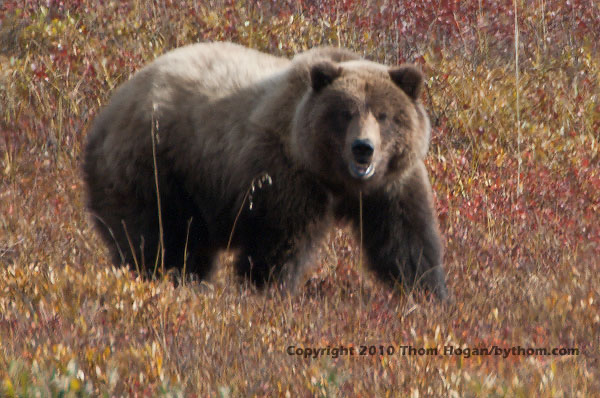
At distance with teleconverter (and certainly wide open as here), the lens sometimes fails to get the kind of acuity we desire. It's like the optomitrist flipped the wrong correction in front of our eye, as nothing quite resolves into focus.
This led me to a long session of AF Fine Tune. I tried tuning the lens at different distances and shooting different targets (I even bought a small stuffed bear that I could position at distance to test "hair acuity" with). After one heck of a lot of testing, I think I can describe the optical characteristics of the 200-400mm pretty well now.
Basically, my initial impression was right, but there were camera components that intrude and made it tougher to get a clear handle on the problem. Put simply: at very long distances (300 feet or longer) the lens performs clearly less well than at shorter distances. Note that this implies something for teleconverter use, too, as you generally are using teleconverters for more distant subjects.
Now, I know what you're thinking: "hey Thom, dude, what are you smoking; no lens is going to resolve bear hair at 300 feet." Well, you're wrong. My 400mm f/2.8 VR does. Indeed, when I shoot that side by side with the 200-400mm, it's clearer than ever to me that the 200-400mm isn't a distance lens. Where that crossover between superb (closer focusing) and adequate (far focusing) occurs on the 200-400mm, I'm not 100% positive about. I know a lot of sideline shooters that have the 200-400mm and love it, so shooting across the width of an American football field must still be in the realm of "close." Shooting the length of the soccer field puts you in the "far" category, though.
This explains why so many people thought I was nuts when I first wrote that I thought the 200-400mm had some sort of sharpness issue: most people weren't shooting with it at distances that would trigger the problem. But National Park service regulations keep us wildlife photographers at long distances from some animals (e.g. the grizzly), so I was occassionally seeing the poor end of the 200-400's performance.
I will say this: proper AF Fine Tuning and removing the protective front clear glass element both improve things a bit for far focus use of the lens. It still doesn't quite match my 400mm f/2.8 at longer distances (it does at shorter ones), so neither of those things is a perfect solution.
So, at shorter sideline and close animal approach distances, the 200-400mm is a real winner. It's dead on sharp and quite impressive. But watch out when your subject is far off; the lens starts to let down a bit on resolving power as you approach infinity focus.
Some of you will be tempted to use converters on the 200-400mm to give it more reach. Here's the thing: that means you're likely shooting at longer distances from the subject. So you trigger the "far focus fade" as I've come to call it. That plus the acuity loss from the converter itself can put the combination beyond what I call usable.
Indeed, I've pretty much stopped using converters with this lens. Even when I do, I won't use a TC-14E on the old 200-400mm without stopping down a stop, as the lens isn't as tolerant of the old converters as the other Nikon exotic telephotos (on the newer model, I’ll sometimes leave the lens wide open; it seems to tolerate the TC-14E a bit better).
And, as I've already mentioned, only the TC-14E really keeps things within the realm of top Nikon autofocus performance anyway. That means you'll be shooting, at best, with a 560mm f/8 lens (one stop for the converter loss, one stop to recover some performance). That may sound okay to you, but the same converter on the 400mm f/2.8 doesn't require stopping down to obtain top performance, so you're two stops slower with the 200-400+TC-14E than you would be with the 400+TC-14E (actually, a bit more, since the 400mm f/2.8 starts at about t/3.2). And less sharp. As much as I like the convenience of the zoom, I now realize that I'm giving up something optically, too.
So I'm putting some caveats on this lens for best possible performance:
- Use it at close to modest distances.
- Don't try to extend it with a teleconverter.
- Consider removing the protective glass for anything but the closest distances.
(But note that the protective glass is there because it's much less costly to replace than the actual front element of the lens. Don't remove the protective glass unless you're certain you're not in conditions where things might harm the front element. Fortunately, the hood is so deep (almost 6") that with it on the glass is reasonably well protected, but don't make the decision to remove the protective element lightly.)
Now for some good news: the lens is sharpest wide open, and it doesn't really lose much performance until diffraction starts to take resolution away (as early as f/8 on the D3x, f/5.6 on a D810). So don't be afraid to use it wide open. Even with the far distance issue, f/4 is the best aperture.
Likewise, performance at 400mm is still excellent (performance is slightly better at 200mm). Most telephoto zooms are weak at the longest focal length, but I'd say that the 200-400mm holds up very strongly throughout its range, with 400mm being only marginally softer than the lower focal lengths. Another big plus: center and corner performance is remarkably close. This is not a lens that goes noticeably soft in the corners like the 70-200mm does. DX users can rejoice even further: you're only using the center of the imaging circle, so corners are about as good as you can ever expect.
Side note: I’ve used a lot 200-400mm’s now. In my personal case, the newer one was slightly better than my older version. However, I’d say that these were probably near the extremes of sample error. I’ve seen older versions that are slightly better than the newer ones, and vice versa.
I'm only going to present some 400mm results here, but other focal lengths showed similar tendencies:
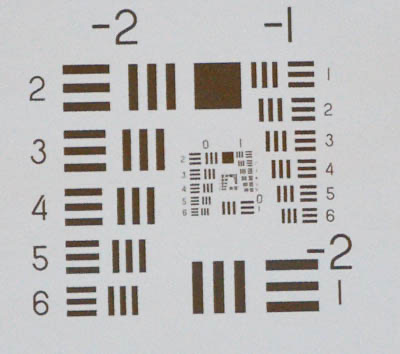
center f/4
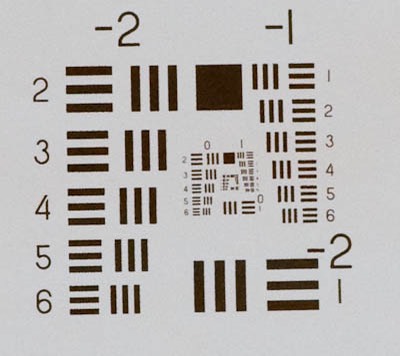
center f/8
Notice that the center is sharp both wide open and especially stopped down. There is some loss of contrast wide open, but sharpness is not in question.
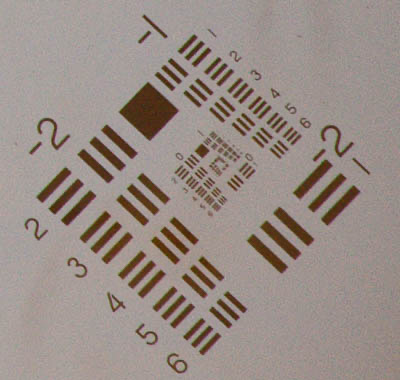
corner f/4
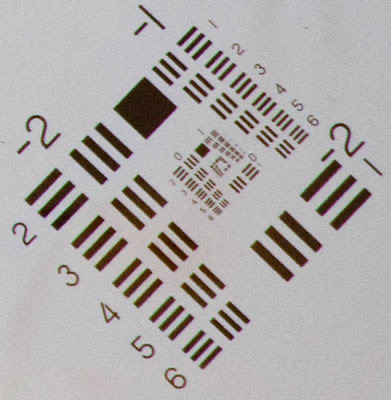
corner f/8
In the corners, things are a bit different. As you stop down you lose a bit of sharpness in the corners, though you get very little vignetting (the difference in brightness of the two images, which I haven’t processed here).
The newer version of the lens exhibits pretty much the same sharpness tendencies as the original AF-S version. At close distances both are superb, while at great distances they are not. There are very small differences between my two samples in sharpness, but the differences are small enough they may be within sample variation.
I will say that my new version is not quite a tack sharp as my old version. It's a very small difference, and one most people wouldn't notice, but it's there. The newer samples I’ve seen seem to be the same compared to the older samples, but the difference is substantially small, and not worth agonizing over. They constitute no more than a 1% difference on MTF tests, but they are consistently skewed towards the older lens.
Light falloff: There's noticeable corner vignetting wide open, which is mostly gone by f/8. Generally, I haven't found the vignetting to be a problem. The type of subjects you'd usually shoot with this lens actually benefit a bit from the darker corners at f/4.
Chromatic aberration: Very consistent and at very low levels across all the apertures and focal lengths. Surprising for a zoom lens, actually. Those four ED elements are doing their job.
Flare: Use the hood and flare is almost never an issue. Don't use the hood and you'll see a clear drop in contrast using this lens. I also see a slight contrast boost in removing the protective front element.
The one place where there is an observable difference to the older model is in backlit scenes. The new Nano coating does seem to increase contrast a bit in such situations. Enough to be visible, not enough to get excited about.
Distortion: close to zilch. I can't get an accurate measurement for linear distortion off my test charts, as it's well less than a half percent (barrel).
Bokeh: There's just a teeny bit of complexity to the out-of-focus areas at smaller than the maximum aperture that keeps me from saying the bokeh is excellent. I'm not sure where that's coming from, as the lens uses a very well-rounded 9-blade aperture, and there are no real chromatic aberration issues that would cause that. Some of the bokeh complexity may be VR artifacts, as I can see a difference when using VR versus when not using VR.
This also leads me to think that the complexity may simply be camera motion issues: if you have a near subject and a distant background, the optical center of this lens is so far out from the camera even a little camera movement fulcrums the distance a good bit.
Other: Another strange bit to the 200-400mm is that its color transmission properties are little bit off from the other exotics. The glass in the 200-400mm seems to transmit a bit more blue than expected. I'm constantly having to do minor tweaks to my 200-400mm shots with white balance because of this.
My final observed difference isn't really so much a difference between the older and newer models, but between older and newer teleconverters. Simply put, I was very surprised at the results with the TC-20E III on both the old and new version of the 200-400mm. I had originally concluded that teleconverters were not a strong point of this lens: the only usable one at the time I originally wrote the review was the TC-14E and that needed to be stopped down a stop to get what I felt were acceptable results.
The TC-20E III, however, was a surprise. On my original 200-400mm wide open I would call the optical performance excellent for a teleconverter/lens combo. On the newer 200-400mm design wide open I would call the performance very good. In both cases the TC-20E III shot wide open delivered better results than my original TC-14E closed down a stop.
There's some kind of magic in that TC-20E III, and you notice it immediately with either 200-400mm. Autofocus is still haphazard with the TC-20E III, though, as you're at f/8 and beyond the stated specs of the Nikon system for many models, and right at the margin for the others. Still, I found it usable for many static test subjects, and contrast based AF with Live View seemed to always work just fine. You cannot rely on the lens to track focus dependably with the TC-20E III on it.
Let me put things in perspective. At about the distance at which I think the 200-400mm optical performance starts to decline (200-300 feet) with the TC-20E III on, I was reading small lettering off the ID plate of a transformer, and the edges were crisp. That was not true with the TC-17E on the lens. Not even close to true.
Final Words
Whether the 200-400mm f/4 is the right lens for you has to do solely with two things, I believe: is f/4 okay for you, and do you shoot at long distances? The right answers should be yes and no, respectively. Any other set of answers means you need to look at the alternatives.
Compared to the 400mm f/2.8: Surprisingly close at 400mm f/4 for near to moderate distant subjects. But the 400mm f/2.8 is better, no questions asked. Thus, the question is whether the image quality compromise is small enough that the other compromises (price, weight, size, handling) factor in the 200-400mm's favor. Based upon which lens I keep taking to Africa, I'd say yes. You don't give up a lot, but you gain some ability to handhold in an emergency, the flexibility of a zoom, and a smaller and lighter pack.
Finally, the 400mm f/2.8 tolerates all three TCs well, while the 200-400mm tolerates only the TC-14E, TC-14EIII, and TC-20E III acceptably, and with limitations for each. If you think you'll need more reach than 400mm, the 200-400mm+TC is not the best solution, in my opinion.
I should also report that the 400mm f/5.6 (an AI-S lens) also outperforms the 200-400mm at longer distances in my experience (though not at shorter distances). That's assuming that you can focus it carefully enough, since it is a manual focus lens.
Compared to the 200-500mm f/5.6: At close distances I prefer the 200-400mm at 400mm, there’s not a lot to distinguish between the two at 200mm.
But the 200-500mm f/5.6 doesn’t have the long distance let down the 200-400mm does, so at about 100 yards the 200-500mm is clearly outperforming the 200-400mm, even with the 200-400mm stopped down to match.
Personally, I sold my 200-400mm f/4 and use the 200-500mm f/5.6 when I need a good telephoto zoom, as I’m often dealing with distant subjects. But that loss of a stop is something that you might not be able to tolerate, even given how good the higher ISO results are with recent cameras. If I were mostly shooting sports where I had good sideline access, I probably would have kept the 200-400mm; the 200-500mm isn’t a good substitute for that type of usage, in my opinion.
I also use my 400mm f/2.8 when I need absolute best results. But most of you are looking for the one-lens answer.
Some have read my condemnation of the long distance ability of the 200-400mm as meaning you shouldn’t consider it. No, that’s not right. It’s a weaker lens at distance, but still usable, especially compared to some consumer-level zooms you might try (e.g. 70-300mm). Used at subject distances less than 50m it’s an excellent lens in every respect. It’s really only a few sports (soccer) and some wildlife shooting (Tanzania, where you can’t go off road) where the distance weakness should make you think carefully about whether this is the right lens for you. Most of you will find it excellent for the uses you put it to.
Recommended (2014 to 2018) (with distance reservation)
Support this site by purchasing from this advertiser:
